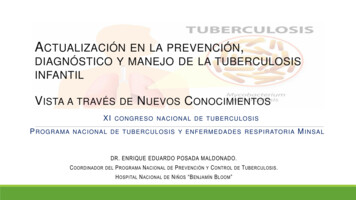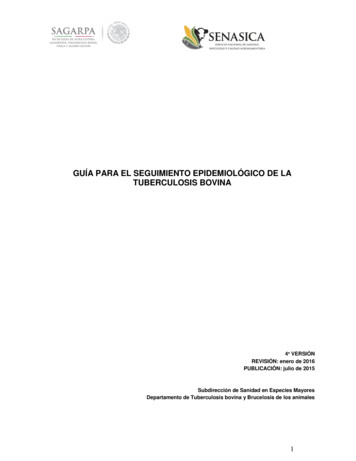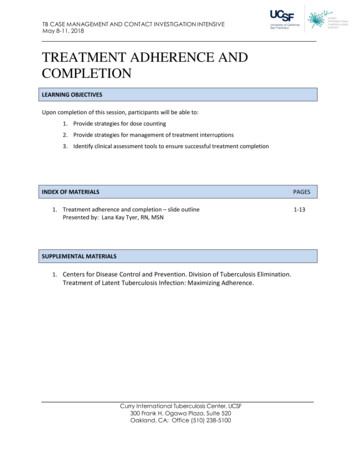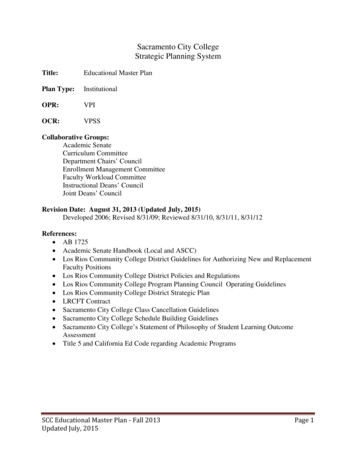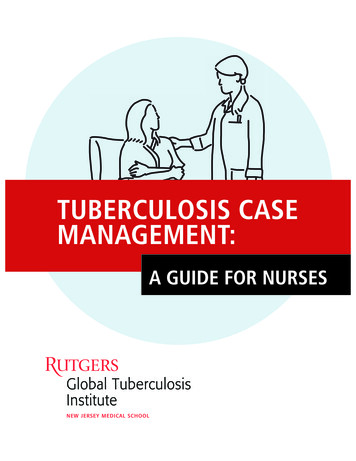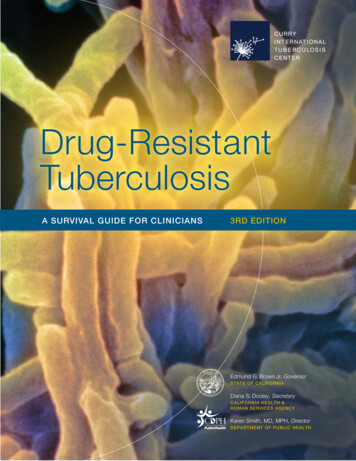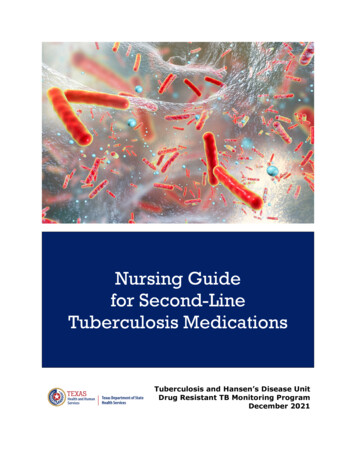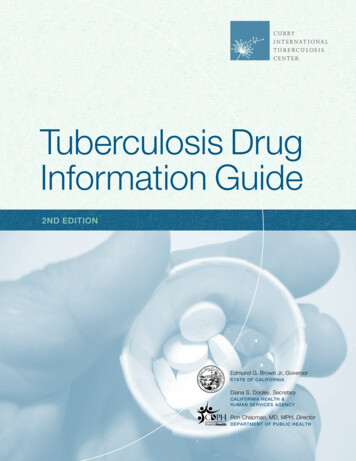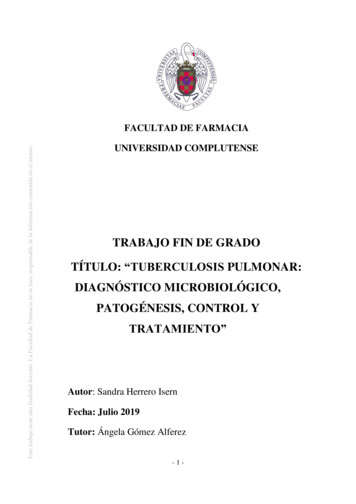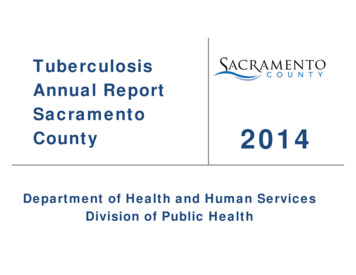
Transcription
TuberculosisAnnual ReportSacramentoCounty2014Department of Health and Human ServicesDivision of Public Health
Tuberculosis Annual Report 2014Release date: December 15, 2015Prepared by:Helen Zheng, MPHJamie S. White, MPHKasirye, Olivia C., MD, MSSacramento CountyDepartment of Health and Human ServicesPublic Health DivisionDisease Control and Epidemiology Unit7001‐A East Parkway, Suite 600Sacramento, CA 95823Phone: 916‐875‐5881TTY: 877‐835‐2929Website: www.scph.com
Table of Contents2014INTRODUCTION . 1EXECUTIVE SUMMARY . 2TECHNICAL NOTES . 5TUBERCULOSIS IN SACRAMENTO COUNTY . 7TB TRENDS BY YEAR . 7TB BY CITY OF RESIDENCE. 8TB BY ZIP CODE OF RESIDENCE . 9DEMOGRAPHICS .10TB BY AGE GROUP . 10TB BY GENDER . 11TB BY RACE/ETHNICITY . 12ORIGIN AND COUNTY OF BIRTH .13U.S.–BORN CASES. 13FOREIGN–BORN CASES . 14COUNTRIES OF BIRTH. 15TUBERCULOSIS CLINICAL AND LABORATORY PROFILE .16TB SITES OF DISEASE . 16TB CASE VERIFICATION . 17TB DRUG RESISTANCE . 18TUBERCULOSIS THERAPY OUTCOME .19TB THERAPY OUTCOME . 19TUBERCULOSIS RISK FACTORS .20TB RISK FACTORS . 20TB AMONG HOMELESS PERSONS . 21iTuberculosis Annual Report - Public Health - Sacramento County
Introduction2014IntroductionTuberculosis (TB) is an airborne disease caused by a group of bacteria referred to as the Mycobacterium tuberculosis (MTB) complex. The fivespecies in this complex are M. tuberculosis, M. bovis, M. africanum, M. canettii, and M. microti. General symptoms of TB disease may include aprolonged productive cough, blood‐tinged sputum, night sweats, fever, fatigue, and weight loss. TB most commonly affects the lungs, but canalso affect other parts of the body like the brain, kidneys, or spine. TB bacteria are aerosolized into respiratory droplet nuclei when a person whohas TB of the lungs or larynx coughs, sneezes, laughs, or sings. Subsequently, another person inhales the droplet nuclei that are formed.Individuals who become infected but do not become ill are considered to have latent TB infection (LTBI) and cannot transmit the infection toothers. LTBI is evidenced by a positive tuberculin skin test (TST) or a positive blood test using T‐cell Inteferon‐Gamma Release Assay (TIGRA)testing and without evidence of disease after evaluation. Approximately 10% of infected individuals will progress to active disease at some pointin their lives. During 2014, there were 71 new cases of TB reported to the County of Sacramento, Division of Public Health. Globally, anti‐TBTreatment has made a significant impact on lowering the rate of active TB and deaths due to TB. However, many challenges still remain,including the increase in multi‐drug resistant TB.PurposeThe purpose of this report is to provide the community with an overview and enhanced understanding of TB in Sacramento County includingtrends, the distribution of TB cases, racial disparities, multi‐drug resistance, TB among vulnerable populations, and TB therapy outcomes.AcknowledgmentsThe Division of Public Health acknowledges Chest Clinic staff for their efforts in tuberculosis (TB) control and patient management. We alsoacknowledge staff at the California Department of Public Health (CDPH) Tuberculosis Control Branch (TBCB) for their assistance and guidance inoutbreak management.For comments or questions contactEpidemiology ServicesDivision of Public HealthDepartment of Health and Human Services Sacramento County7001‐A East ParkwaySacramento CA 95823(916) 875‐58811Tuberculosis Annual Report - Public Health - Sacramento County
Executive Summary2014Executive SummaryTuberculosis in Sacramento CountyIn 2014, there were 71 cases of tuberculosis reported in the County of Sacramento, one of whom was dead at time of diagnosis. The incidence rate was 4.9per 100,000 population compared to 5.6 per 100,000 in the State for the same year. The TB incidence rate decreased 53.3% from 10.5 in 2005 to 4.9 in 2014for the County.In 2014, the City of Sacramento had 45 (63.4%) TB cases and an incidence rate of 9.5 per 100,000 population. During the ten‐year period from 2005‐2014, theCity of Sacramento had the majority of the TB cases (71.7%) compared to all other cities in the County, and had an average TB incidence rate of 14.2 per100,000 population. This rate was more than double the average rate of 6.4 for the listed ten‐year period in Sacramento County.In 2014, 57 out of 71 (80.3%) cases were diagnosed with pulmonary TB. Fifty‐nine were laboratory‐confirmed TB cases and 12 were clinic‐confirmed TBcases. Of the 914 TB cases diagnosed from 2005 to2014, 724 (79.2%) were diagnosed with pulmonary TB. 74.5% were laboratory‐confirmed TB and 25.5%were clinic‐confirmed TB.Of the 914 TB cases diagnosed from 2005‐2014, 23.2% of TB cases were concentrated in zip codes 95823, 95828 and 95824. Over 50% of TB cases weredistributed in the following zip codes: 95823, 95828, 95824, 95758, 95822, 95624, 95814, 95838, 95820 and 95757.DemographicsTB incidence affected all age groups. In the past ten years, 31.6% of TB cases were ages 45‐64 years, 27.5% were ages 25‐44 , 25.9% were ages 65 and olderand 10.8% were ages 15‐24. Only 4.2% of TB cases in the past ten years were among children less than 15 years of age. The three‐year average incidence ratedecreased more than 35% from 2003‐2005 to 2012‐2014 for all age groups, especially for age less than 15, which dropped more than 70%.In 2014, there were 37 female TB cases and 34 male TB cases with an incidence rate of 5.0 and 4.7 per 100,000 population, respectively. From 2005 to 2014,the incidence rate decreased 59.8% for males and 44.6% for females.Asian/Pacific Islanders had the highest TB incidence rate among all race/ethnicity groups across all listed year in the County. In 2014, the TB rate amongAsian/Pacific Islanders was 20.3, 17.1, and 8.4 times higher than the rates among Caucasians, African American, and Hispanic, respectively. Asian/PacificIslanders accounted for 73.2% of total cases in 2014. Over the ten‐year period from 2005‐2014, Asian/Pacific Islanders accounted for 60.3% of 914 totalcases, with an average annual incidence rate of 27.3 per 100,000 population, which is 4.3 times higher than the overall average incidence rate for the tenyears.2Tuberculosis Annual Report - Public Health - Sacramento County
Executive Summary2014Origin and Country of BirthIn 2014, 73.2% of TB cases were among the foreign‐born. The number of TB cases among foreign‐born persons in Sacramento County was 2.7 times higherthan that of U.S.‐born persons. From 2005 to 2014, 69.1% of TB cases among foreign‐born persons occurred in persons from five countries: Philippines(117), Vietnam (116), Mexico (76), Laos (71), and India (68).Tuberculosis Drug ResistanceIn 2014, six TB cases were resistance to the first‐line TB treatment drug isoniazid. From 2005‐2014, for those TB cases who had susceptibility testing done,9.5% were resistant to isoniazid, 2.2% resistant to rifampin, 3.4% resistant to pyrazinamide and 3.2% to ethambutol.Multi‐drug resistant TB (MDR TB) is caused when a TB organism is resistant to at least isoniazid and rifampin. In 2014, multi‐drug resistance (MDR)susceptibility testing was performed for 54 TB cases, with zero cases of multi‐drug resistance. During the ten‐year period from 2005‐2014, 12 TB cases weremulti‐drug resistant. All MDR cases were among foreign‐born persons.Tuberculosis Risk FactorsIn 2014, 21.1% of TB cases also had a diabetes mellitus diagnosis.In 2014, there were zero homeless TB cases in the County. There were 68 homeless TB cases from 2005‐2014; 75% of them were male and 25% were female.The majority of homeless TB cases in Sacramento County occurred among Whites (50.0%) and Blacks or African Americans (29.4%).3Tuberculosis Annual Report - Public Health - Sacramento County
Technical Notes2014Technical NotesTuberculosis SurveillanceSacramento County healthcare providers and laboratories are required by law to report cases of active tuberculosis (TB) to the Sacramento County PublicHealth Department by electronic transmission, telephone, or mail within one working day of identification. The Sacramento County Public HealthDepartment TB Control Program investigates and reports TB cases to the California Department of Public Health (CDPH) Tuberculosis Branch Control Branch(TBCB) using a standard case report form, Report of Verified Case of Tuberculosis (RVCT). In 1993, the Centers for Disease Control and Prevention (CDC), inconjunction with state and local health departments, began using the Report of Verified Case of Tuberculosis (RVCT) form to collect information on each caseof TB. In 2009, the RVCT was modified and expanded to include 11 additional variables. Modifications to the RVCT accommodate the changing epidemiologyof TB in terms of risk factors, new drug treatments, and enhanced laboratory capacity for diagnostic tests. TB cases are reported and counted according tothe Centers for Disease Control and Prevention’s (CDC) Recommendations for Reporting and Counting Tuberculosis Cases.TB Case DefinitionA TB case is defined as active disease, not old infections or Latent Tuberculosis Infection (LTBI). In 2009, the TB case definition was modified. TB cases areverified according to the following specified laboratory and clinical criteria.Laboratory Criteria for DiagnosisA case may be verified by the laboratory case definition with at least one of the following criteria: 1) isolation of M. tuberculosis complex from a clinicalspecimen, OR 2) demonstration of M. tuberculosis complex from a clinical specimen by nucleic acid amplification test (NAAT), OR 3) demonstration of acid‐fast bacilli (AFB) in a clinical specimen when a culture has not been or cannot be obtained or is falsely negative or contaminated.Clinical Case CriteriaA case may be verified by the clinical case definition in the presence of ALL of the following clinical criteria: 1) a positive tuberculin skin test (TST) result orpositive interferon gamma release assay (IGRA) result for M. tuberculosis, AND 2) other signs and symptoms compatible with TB (e.g., abnormal chestradiograph, abnormal chest computerized tomography scan or other chest imaging study, or clinical evidence of current disease, AND 3) treatment with twoor more anti‐TB drugs, AND 4) a completed diagnostic evaluation.5Tuberculosis Annual Report - Public Health - Sacramento County
Technical Notes2014Provider DiagnosisWhen cases of TB are diagnosed but do not meet either the clinical or laboratory case definition, reporting areas have the option of verifying TB cases basedon provider diagnosis.RatesRates are expressed as the number of cases reported each calendar year per 100,000 persons. Population denominators used in calculating TB rates werebased on the State of California, Department of Finance (DOF) State of California, Department of Finance, Race/Ethnic Population with Age and Sex Detail,2000–2050. Sacramento, CA, July 2007 and Race/Ethnic Population with Age and Sex Detail, 2010–2060. Sacramento, CA, January 2013.Race/Ethnicity CategorizationPersons of Hispanic/Latino ethnicity are categorized as Hispanic regardless of race. Persons of non‐Hispanic/non‐Latino ethnicity are categorized according torace (American Indian or Alaskan Native; Asian, Native Hawaiian or Other Pacific Islander; Black or African American, and White). Multiple race indicates aperson of non‐Hispanic/non‐Latino origin with two or more races reported.Tuberculosis Therapy OutcomesData collected by RVCT Follow‐Up Report 2 on date and reason therapy stopped were uses to determine therapy outcomes.6Tuberculosis Annual Report - Public Health - Sacramento County
Tuberculosis in Sacramento County2014Tuberculosis in Sacramento CountyFigure1. Number of TB Cases, Sacramento County, 1995‐2014TB Trends by YearThe incidence rate forSacramento County hasdropped 53.3% from 10.5 per100,000 in 2005 to 4.9 per100,000 in 2014.71209060301995 1996 1997 1998 1999 2000 2001 2002 2003 2004 2005 2006 2007 2008 2009 2010 2011 2012 2013 2014TB 71Figure 2. TB Incidence Rates, Sacramento County, 2005‐201412.0Case Rate per 100,000Figure 2 shows TB trends inSacramento County comparedto the state of California for thepast ten years. Statewideincidence rates have steadilydeclined, while rates for theCounty have fluctuated due tosporadic local outbreaks andchanges in immigrationpatterns.150Number of CasesFor the 20‐year periodfrom1995 to 2014, theincidence of TB has decreased88.7%, from 134 cases to 71cases (Figure 1). In the pastten years the TB cases havedecreased by half from 142 in2005 to 71 in 2014.18010.08.06.04.02.00.02005Sacramento 85.75.6Tuberculosis Annual Report - Public Health - Sacramento County
Tuberculosis in Sacramento CountyFigure 3. TB Incidence Rates by Select City and County, Sacramento County, 2005‐2014Figure 3 shows TB incidence rates byselect cities and for SacramentoCounty. The city of Sacramento had aTB incidence rate consistently higherthan the overall County rate.However, the TB incidence rate forthe city of Sacramento decreasedfrom 27.3 per 100,000 in 2005 to 9.5per 100,000 in 2014.In 2014, the city of Sacramento hadthe majority of TB cases (45) in theCounty, but the percentage of TBcases in the city of Sacramentodecreased from 85.2% in 2005 to63.4% in 2014 (Table 2).The ten‐year average incidence ratefor the city of Sacramento is morethan double the average incidencerate for the entire county. The city ofElk Grove also had a higher ten‐yearaverage incidence rate compared tothe county (Table 2).30.025.0Rate per 100,000TB by City of 0920102011Sacramento27.314.8Elk Table 2. TB Incidence Rates by City, Sacramento County, 2005‐2014CitySacramentoElk GroveBalance Of CountyRancho CordovaFolsomCitrus HeightsGaltTotal2014 TB Cases2005‐2014 TB losis Annual Report - Public Health - Sacramento County
Tuberculosis in Sacramento CountyMap 1. Number of TB Case by Zip Code, Sacramento County, 2005‐2014TB by Zip Code ofResidenceThere were a total of 914cumulative Tuberculosis (TB)cases reported in SacramentoCounty from 2005 to 2014(Map 1). Nearly 50% of all TBcases were concentrated withinthe geographic area denoted bythe black circle. 23.2% of TBcases were within zip codes95823, 95828 and 95824. Theareas with the highest numberof cases tend to be morepopulous urban areas in thewestern portion of the County.9Tuberculosis Annual Report - Public Health - Sacramento County2014
DemographicsTB by Age GroupTable 3 shows TB cases by yearand age at time of diagnosis.Persons age less than 15represent a very low proportionof the total TB cases across alllisted years.Age group 45‐64 had the highestproportion of TB cases (31.6%) inthe past ten years, followed byage group 25‐44 (27.5%) (Figure4).2014DemographicsTable 3. TB Cases by Year and Age Group,Figure 4. Proportion of TB Cases by Age Group,Sacramento County, 2005‐2014Sacramento County, 2005‐2014Year0‐45‐1415‐24 25‐44 45‐6465 20151222207165 ‐4427.5%Figure 5. Three‐Year Average TB Incidence Rate by Age Group, Sacramento County, 2005‐2014Three‐year average incidencerates are presented in Figure 5.Age group 65 and older had thehighest incidence rate across allyears. From 2003‐2005 to 2012‐2014, the incidence ratesignificantly decreased for all agegroups; 84.1% for age group 5‐14, 63.5% for age group 0‐4,60.1% for age group 25‐44,59.7% for age group 45‐64,50.7% for age group 65 and olderand 35.3% for age group 15‐24.10Tuberculosis Annual Report - Public Health - Sacramento County
Demographics2014Figure 6. TB Cases by Gender, Sacramento County, 2005‐2014In Sacramento County, maleshave historically had higher TBincidence rates than females(Figure 6). However, in 2014females had a slightly highernumber of cases and incidencerate than males in 422831253337Figure 7. TB Incidence Rate by Gender, Sacramento County, 2005‐201412.0Rate per 100,000For the past ten years, male TBincidence rates decreased59.8% from 11.7 per 100,000population in 2005 to 4.7 per100,000 population in 2014.The female incidence ratedecreased 44.6% in the sametime period.TB CasesTB by emale9.06.56.85.95.73.94.33.44.55.0Tuberculosis Annual Report - Public Health - Sacramento County
Demographics2014Figure 8. TB Incidence Rate by Race/Ethnicity, Sacramento County, 2005‐2014, Sacramento CountyTB by Race/Ethnicity50.0Asian/Pacific Islanders made upthe majority of TB cases inSacramento County in the pastten years. Figure 9 and Figure10 show the proportion of TBcases by race/ethnicity group inthe past ten years and for 2014,respectively.40.0Rate per 100,000TB incidence rates decreasedover the past ten years acrossall race/ethnicity groups (Figure8). Blacks had the largestdecrease (92.4%) from 17.9 per100,000 population in 2005 to1.4 per 100,000 in 2014.Whites decreased 63.1%,Hispanics dropped 66.5% andAsian/Pacific islanders declinedonly 18.719.918.825.423.3Figure 9. Proportion of TB Cases byRace/Ethnicity, Sacramento County, 2005‐2014Other0.5%White11.3% Black2.8%White13.5%Black10.8%Asian/PI60.3%12Figure 10. Proportion of TB Cases byRace/Ethnicity, Sacramento County, losis Annual Report - Public Health - Sacramento County
Origin and Country of Birth2014Figure11. ProportionU.S.‐Born TB CasesbyOriginandof Countyof BirthRace/Ethnicity, Sacramento County, 2005‐2014U.S.–Born CasesFrom 2005 to 2014, there were914 TB cases reported inSacramento County and 251(27.5%) were U.S.‐born TBcases. Among these TB cases34.7% were White, 30.3% wereBlack, 19.9% were Asian/PacificIslander and 14.3% wereHispanic (Figure 11).Figure 12. Proportion of U.S.‐Born TB Cases by AgeGroup, Sacramento County, c14.3%Black30.3%65 17.9%45‐6429.5%5‐144.8%25‐4424.3%* American Indian Alaska Native0‐46.8%15‐2416.7%Table 4. U.S.‐Born TB Cases by Gender, Race/Ethnicity and Age Group, Sacramento County, 2005‐2014TB affected all age groupsamong the U.S.‐born. Thegreatest proportion was amongage group 25 to 64, which had53.8% of all U.S.‐born TB cases(Figure 12). Table 4 shows thenumber of U.S.‐born TB casesby gender, race/ethnicity andage group.13TB ispanicAsian/Pacific IslanderAmerican Indiam/Alaska NativeAge Group0‐45‐1415‐2425‐4445‐6465 3523124274209431Tuberculosis Annual Report - Public Health - Sacramento County
Origin and Country of BirthForeign–Born Cases2014Figure 13. TB Proportion by Race/Ethnicity forForeign‐Born, 2005‐2014, Sacramento CountyAmong the 914 reported TBcases from 2005 to 2014, 649(71.0%) of them were foreign‐born TB cases. Among theseforeign‐born cases, 76.0% wereAsian/Pacific Islander, 14.9%were Hispanic, 5.5% wereWhite and 3.5% were Black(Figure 13).Compared to U.S.‐born TBcases, foreign‐born TB caseshad a smaller proportion ofpeople in the age groups below25 years. The other age groupsall have higher proportionsthan U.S.‐born cases (Figure14). Table 5 shows the numberof foreign–born TB cases bygender, race/ethnicity and age.14Figure 14. TB Proportion by Age Group forForeign‐Born, 2005‐2014, Sacramento CountyWhite5.5%AsianPacificIslander76.0%65 %5‐141.4%15‐248.8%Table 5. Foreign‐Born TB Cases by Gender, Race/Ethnicity and Age Group, 2005‐2014, Sacramento CountyTB ispanicAsian/Pacific IslanderAge Group0‐45‐1415‐2425‐4445‐6465 rculosis Annual Report - Public Health - Sacramento County
Origin and Country of Birth2014Graph 15. Proportion of TB Cases by Country of Origin, Sacramento County, 2005‐2014Countries of BirthFrom 2005 to 2014, 649 (71.0%)TB cases in Sacramento Countywere foreign‐born. The top 5countries of birth among foreign‐born cases were the Philippines(18.0%), Vietnam (17.9%), Mexico(11.7%), Laos (10.9%) and India(10.5%). These five countries oforigin represent 69.0% of allforeign‐born TB cases (Graph 15).Table 6 lists all foreign‐born TBcases by country of origin andnumber of years of in the USA.About 21% of foreign‐born TBcases had stayed in USA for lessthan one year and over 27% hadstayed for more than 20 yearsbefore becoming sick with TBdisease. TB cases from Thailand,India, Ukraine, Ethiopia and thePhilippines were much more likelyto be recent immigrants comparedto TB case from Cambodia,Vietnam, Laos or China.15Table 6. Foreign‐Born TB Cases by Number of Years in the US, Sacramento County, 2005‐2014Time In United StateCountry ofOriginTotal 1 Year1‐2 Year3‐5 Year6‐10 Vietnam1162219.010.997.8M exic 37513.5123834.81ThailandUk raine* China13includes4 Hong30.8 Kong1Ethiopia10311‐20 Year 20 30.0Cam bodia1000.000.0110.000.0220.0660.0110.0All ulosis Annual Report - Public Health - Sacramento County
Tuberculosis Clinical and Laboratory Profile2014Tuberculosis Clinical and Laboratory ProfileTable 7. TB Cases by General Site of Disease, Sacramento County, 2005‐2014TB Sites of DiseaseYearTable 7 lists TB cases by form ofdisease. Pulmonary TB casesrepresent more than 75% of allTB cases across all listed years.PulmonaryCases with a disseminated formof the disease, called miliarydisease, are categorized asboth pulmonary and extra‐pulmonary. There were nomiliary TB cases in the Countyin 2014.16200620072008200920102011No. (%)No. (%)No. (%)115 (80) 73 (75.3) 86 (78.9)201220132014TotalNo. (%)No. (%)No. (%)88 (80)79 (80.6) 50 (76.9)No. (%)No. (%)No. (%)No. (%)No. (%)63 (84)47 (74.6) 66 (78.6) 57 (81.4) 724 (79.3)Extrapulmonary 20 (14.1) 15 (15.5) 18 (16.5) 18 (16.4) 11 (11.2) 12 (18.5) 10 (13.3)9 (14.3)8 (9.5)5 (5.7)126 (13.7)Both64 (7)TotalIn 2014, 80.3% of TB cases hadpulmonary TB only, 7.0% hadextra‐pulmonary TB and 12.7%had both pulmonary and extra‐pulmonary TB (Table 8). Themost common extra‐pulmonarysites of disease were cervicaland pleural.20057 (4.9)9 (9.3)5 (4.6)4 (3.6)8 (8.2)142 (100) 97 (100) 109 (100) 110 (100) 98 (100)3 (4.6)2 (2.7)7 (11.1)10 (11.9)9 (12.9)65 (100)75 (100)63 (100)84 (100)71 (100) 914 (100)Table 8. TB Cases by Specific Anatomical Site, Sacramento County, 2014TB Diagnosis (2014)TotalPulmonary onlyExtrapulmonaryCervicalBonePleuralOther (Liver)BothPulmonary AxillaryPulmonary BonePulmonary CervicalPulmonary PleuralPulmonary Other (Colon)Pulmonary Other (Liver)Number of Cases71575Percent of All ulosis Annual Report - Public Health - Sacramento County1.41.44.22.81.41.4
Tuberculosis Clinical and Laboratory ProfileTB Case VerificationReportable TB cases areverified either by laboratorytesting (culture or smear),clini
2000-2050. Sacramento, CA, July 2007 and Race/Ethnic Population with Age and Sex Detail, 2010-2060. Sacramento, CA, January 2013. Race/Ethnicity Categorization Persons of Hispanic/Latino ethnicity are categorized as Hispanic regardless of race.
